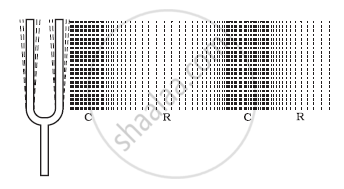Advertisements
Advertisements
Question
Describe with the help of a diagram, how compressions and rarefactions are produced in air near a source of sound.
Solution

Let us assume that a tuning fork is the source of sound.
- When it vibrates and moves forward, it pushes and compresses the air in front of it, thus creating a region of high pressure. This region is called compression (C).
- This compression moves forward away from the vibrating object, such as the tuning fork.
- When the arm of the tuning fork vibrates back inwards (backwards), a low-pressure region is created, which is called rarefaction (R).
- When an object vibrates this way, a series of compressions and rarefactions are created in the air. These compressions and rarefactions form sound waves, which propagate through the medium.
APPEARS IN
RELATED QUESTIONS
Fill in the blank.
Sound can travel in a ______
Is the speed of sound more in water or in steel?
Explain the experiment, with a neat diagram, to prove the following:
'Sound needs material medium for propagation.'
Write the answer in your own words.
Explain with the help of practical examples how sound is propagated through solids.
Does the speed of sound in a gas depend on the pressure of the gas?
Sound cannot travel in ______.
The speed of sound is ______ in solids than in liquids
the speed of sound in air is 331 ms-1 at ______ and ______ at 22°C.
Rarefactions are the regions of ______ where particles are spread apart.
Find the odd one out.
